I make investigations that ask people to become aware of what they are looking at.
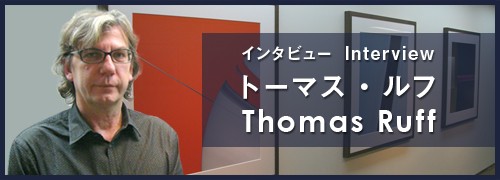
The artist who studied under the Bechers and has since become a key figure in the realm of German Photography was in Tokyo to open his solo outing (at Gallery Koyanagi through 19 December). How does he choose his subjects and objects? What’s the meaning of images in the Internet age? Why has his style changed again and again? A curator well acquainted with the artist’s work probed him about the substance of his creative endeavors.
Interviewer: Iida Takayo (Independent curator)
Text: ART iT
– I’m struck by the elaboration in the works in your solo show here at Gallery Koyanagi. Please tell us something about the concept and inspiration behind this series of abstract lines describing complex movement in space.
The exhibition consists of two different series. The linear series I call zycles, which is a combination of the words for the mathematical formula known as ‘cycloid’ in English and ‘zykloide’ in German. I didn’t like the word in either language so I mixed them. The forms are virtual, generated by a mathematical formula that I manipulate by typing in different coordinates. The formula is very simple: one point rotating around a circle, and this circle rotating around another circle. It’s a double cycle common to us all: the earth rotating on its axis and around the sun.
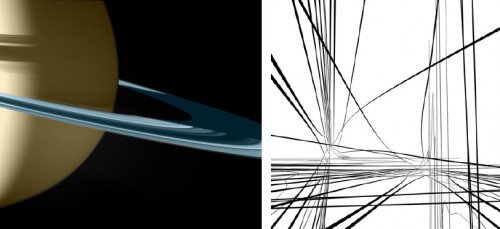
Left: cassini 10 2009
Right: zycles 6021 2009
Wanting to create ‘the image before the image’
I’m very interested in the methods and grammar of photography, of how photography is looked at and distributed these days. We now have a lot of photographs that are no longer photographed, but created on a computer. It’s virtual reality. So the idea was to create a form of virtual reality, but not as a realistic image. Because the computer is just bits and bytes, I wanted to create ‘the image before the image’. And that for me, if you create it with a computer, is mathematics.
– How do you choose your subjects and your objects?
Most of my series are autobiographical. I’m a normal person like you – I live my private life, I read the newspaper, I watch TV, and in doing so I find things that amuse me, things that make me upset, things that just interest me. And when the reaction is strong enough, I start thinking of creating images about that theme.
Take the green light for the Nacht series. In 1991, when I was in Dusseldorf, I saw those green night visions from the first Gulf War for the first time on TV. On one hand I was shocked that television was broadcasting war in real time to our Western homes and on the other hand I was fascinated by the technology that enables us to see at night in total darkness. So it was a mix of fascination and shock.
– You’ve called that series a metaphor for television voyeurism, but the images are really a brilliant fusion of the technology, the visual content, the visual aesthetics and the political context.
At the time I felt this was not just a war between the US and Iraq, but of the Western industrialized world securing oil production. I therefore felt that as a German I was also part of that war. So I decided to use this kind of light-amplification system and walk through the city of Düsseldorf, and have a look at the city in its state of war.
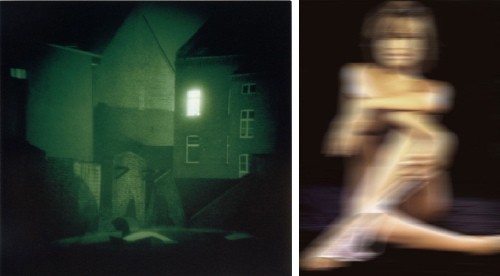
Left: nacht 1 II 1992
Right: nudes kn 30 2000
– You’ve also made use of Internet images in creating your Nudes series. What led you to that medium and that subject?
The nudes are not really about pornography, even though most of the images come from pornographic sites. They are more about voyeurism and exhibitionism, which are very prevalent these days. On TV, there are people who’d do just about anything on some of these reality shows, and to me that’s obscene; it is also very exhibitionistic. You have the same on porno sites, where there are pages on which a husband who is proud of his wife’s big breasts, shows them, and then you have the other guys who are watching. So the nudes are a comment on the Internet. Sex is the oldest profession in the world, and this profession immediately took advantage of this new technology and the possible ways of making money with it.
– My first exposure to your work was your large-scale, emotionless series of Portraits at the 303 Gallery. What was the concept behind those portraits?
I wanted to create a portrait of my generation, so I started with my friends and colleagues at the art academy. My heroes at the time were the conceptual and minimalist artists, so I also tried to take portraiture to degree zero, where there is no information about the person, no emotion. You can only look at the face, and from that start to imagine who this person might be.
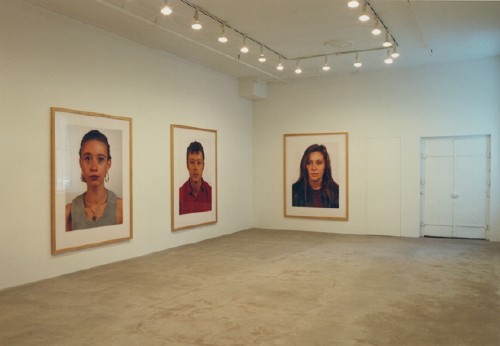
Installation view at 303 Gallery, New York 1989
Days under Becher
– Let’s talk about your student days. What made you choose the Düsseldorf Art Academy and Bernd Becher as a teacher?
That happened by chance. In 1977, when I wanted to study photography, Düsseldorf was the only art academy in all of Germany that had a major in photography, so I applied there, and Becher was teaching the course at the time.
Becher started teaching there in 1976, and his first students were Candida Höfer, Thomas Struth, and Axel Hütte. I joined the class in ’78, so I was a junior student while Struth and Hütte were seniors, and a senior student when Andreas Gursky joined the class. So we weren’t all together in one class, but on slightly different time scales.
– The Düsseldorf Art Academy has produced so many influential artists. What was the atmosphere like there?
At that time it was very lively because we were the first class studying photography within an art academy, so our friends were painters and sculptors, and this made us very aware of what the different media could and could not do. We found out the potential and the limits of photography.
– And now you teach at the Academy…
I did, from 2000 to 2006.
– What about young students now? Are they different from your generation?
Yes, of course. Perhaps the biggest difference is that they arrive at the academy already thinking about their career as an artist-photographer, whereas when we were students we never imaged we could make money doing photographic art work. We assumed we’d have to do commercial work to make a living and our artistic work on the side. That turning point came at the end of the ’80s. Now all the young photo students assume they will make money with their artistic work.
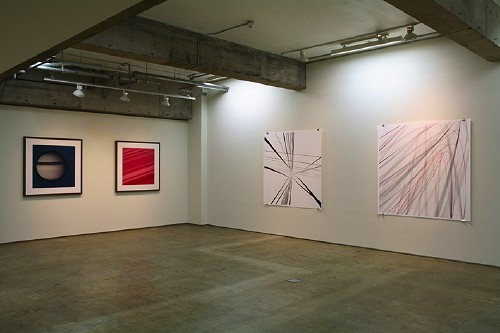
Installation view of Thomas Ruff: cassini + zycles at Gallery Koyanagi 2009
Why the change in styles?
– Throughout your career you’ve made many different series. While they are all very conceptual, they differ drastically in format. Do you yourself feel you are continually changing your style?
Ah, the big question… (Laughs) I only can say that all the works come from the same person. I also think the approach is basically the same in every series. Sometimes I feel as if I’m the big educator, I want to show people images, and I want them to look at images very carefully – not only my images but at the rest of the world’s images too. Images can be very influential; they can manipulate you. I think I can say that with every series, I make an investigation that asks people to become aware of what they are looking at.
Thomas Ruff
Born 1958 in Zell am Harmersbach. Studied photography from 1977 with Bernd and Hilla Becher at the Düsseldorf Art Academy, producing serial shots of residential interiors, buildings and portraits, and thereafter, a wide variety of conceptual series. Participated in Documenta IX in 1992 and the 1995 Venice Biennale, establishing his position in the contemporary art world. His more recent concerns with visual information and the medium of photography have led to manipulating digital images and working with images borrowed from the Internet. At his first solo show in Japan in seven years he presents works from his cassini series of images of planets and zycles series of mathematically formulated and recomposed curved lines.
Iida Takayo
Born 1956 in Tokyo. After organizing shows including Kusama Yayoi and Yokoo Tadanori at the Fuji Television Gallery, became an independent curator in 1990. He has organized and produced exhibitions for the University Museum (The University of Tokyo, Koishikawa Annex), Art Tower Mito, and Mori Art Museum, among others. Among the exhibitions he has curated are Sugimoto Hiroshi (2004), and Yokoo Tadanori (2006) at the Fondation Cartier pour l’art contemporain, War and Art – Terror and Simulacrum of Beauty (2007, 2008, 2009) at the Kyoto University of Art and Design, as well as exhibitions of works by the filmmakers David Lynch, Derek Jerman and Peter Greenaway.
All photos: © Thomas Ruff Courtesy Gallery Koyanagi
ART iT Picks: Thomas Ruff: cassini + zycles
ART iT Snapshots: Thomas Ruff @ Gallery Koyanagi
